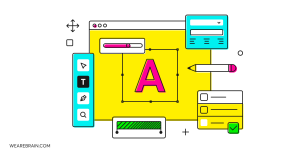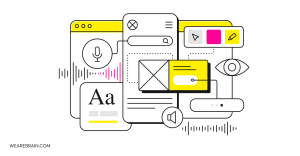Localisation and User Experience 101: How to make your brand a success when going global

Taking your business global for the first time? There are a number of factors you need to be on top of when attempting to land your brand in foreign markets. But for future cost implications, none are more important than getting your localisation on point, specifically regarding your user experience. Realising too late that your user experience is only fit-for-purpose in your own country can become a financial headache when trying to make adjustments later on.
So how can businesses preserve their user experience and ensure it will translate well to foreign markets? Thanks to insight gained from the work of localisation guru Gábor Ugray, your friendly tech geeks at WeAreBrain are here to help you get your brand global with a few tips.
Develop a localisable product
Creating your product to be localisable from the get-go will mean that all your efforts will not be in vain down the line. Any product created to be unintentionally geographically-specific is doomed to fail. Businesses looking to tap into foreign markets need to ensure their digital platforms are optimised for localisation, particularly through the use of language.
All text present on your website – messaging, buttons, pop-ups, labels, calls to action – needs to be translated into the language of your chosen foreign market. When creating your digital platform, be sure not to hardwire text into markup or code so you can make changes as and when required to localise for language, rather than rewriting hardwired code which is a costly and ultimately avoidable expense.
A good example of how localisation affects your user experience can be seen when code glues together messaging. Other than English, there is no language in which to translate only the words ‘You have’ and ‘messages in your inbox’ and expect the result to make sense. So finding a suitable way of communicating this in a different language will affect the overall size and positioning of your buttons, pop-ups and messaging, which will have an impact on your overall user experience. UX designers must be sure to provide meaningful identifiers that help place every piece of text within the product’s context.
Use Human Translators
Machine translation (MT) tools are all good and well when trying to translate short tweets or TripAdvisor reviews, but when it comes to larger pieces of text which require particular context, these tools are no match for human translators. Online translation tools do not possess the hallmarks of human intelligence – contextual understanding, empathy, humour and nuance. When teams simply feed their website copy into a basic translation tool the results are often littered with grammatical errors, lack of context, and come across simply unnatural which immediately alienates audiences.
A good idea is to enlist the services of local experts and linguists to assist you in cross-referencing your campaign before you go all out and promote it. Not only will this provide you with a deep insight into the new market you are entering, but it will also help you land your messaging the right way, first time, within the cultural context of the foreign country’s market you wish to infiltrate.
Your website is not the only asset you need to look at
Translate every part of your site, mobile application, and/or social media platforms. This may appear routine but you will be surprised how many companies only translate the homepage and leave the rest of the pages in their own language. From pop-ups and alerts to navigation elements and menus, every piece of copy needs to be translated. Remember also to translate your promotional content which functions together with your website content. It is also crucial that you remember to translate all updates and features into the language of choice of your target country.
On that note, it is important to consider which languages to use in certain areas of global geography. For instance, if you are looking to get into the Canadian market you will naturally assume an English site will suffice. But if you are wanting to engage audiences in Quebec then you will need to help with translating your content into French. The same with China and the option for both Mandarin and Cantonese. However, issues such as these should already be revealed by your marketing team when conducting audience profiling.
Attention to detail
When localising your product or service, certain elements in need of geographically-specific adjustments in your digital platform can go by unnoticed. For instance, what type of date and time format does your foreign market of choice use? Do they use centigrade or fahrenheit? Do they read right to left or the other way around? What currency do they use?
These are important elements to consider when taking your brand to overseas markets, as one slip up on any of these elements can be detrimental to your business strategy. UX and UI teams need to perform thorough research into all aspects of foreign markets in order to land the right messaging at the right time and to provide memorable user experiences based on culturally-specific norms.
Adapt your brand persona
UX and UI teams know that each design decision made – colours, designs, images, micro-interactions, tone of voice, etc. – develops the personality of a brand, product or service. The gruelling hours of intensive creative efforts by marketing and UX teams to establish a brand identity can be undone in an instant if all these nuanced elements don’t translate directly into other cultures.
What is good for the goose is not necessarily good for the gander when it comes to UX design and brand messaging hopping the pond to infiltrate foreign markets. For example, your brand messaging in English may employ a number of nuanced elements such as dialect, first person or collective, or formal or informal language. Although these may be suitable to your own culture, they may not translate well to foreign contexts.
UX designers have a lot of responsibility when it comes to creating localisable digital experiences where the user experience is key to gaining buy-in from new audiences. They need to be aware of these complex cultural issues and present them in their designs from the get-go. According to Ugray, a good way UX teams can stay on track is to ask important questions at each stage of the design process, such as:
- What are the values underlying the original product’s personality?
- How do those values translate to the target culture?
- What personality will reflect them best?
- What are the consequences of your design choices – all the way down to the smallest decisions?
Of course, UX designers are not language translators nor are they expected to be experts in anthropology and dialectics. But they should be aware of the UX design implications of localising their product and engage with translators and marketers from the country they wish to infiltrate in order to ease the localisation process.
Summary
For businesses looking to break into foreign markets, the first thing that is needed is a good UX design team to help with the localisation process. Retaining brand messaging and user experience can be a fine line to tread, but when the correct measures are taken and confidence is placed in the UX team, the results will speak for themselves. The key is to realise that the process of localisation is a crucial element of brand immersion in foreign markets and so it needs to be treated as fundamental to the success of the business. When your localisation is on point, you can begin to chart your roadmap to global market infiltration.
Paula Ferrai
Working Machines
An executive’s guide to AI and Intelligent Automation. Working Machines takes a look at how the renewed vigour for the development of Artificial Intelligence and Intelligent Automation technology has begun to change how businesses operate.







